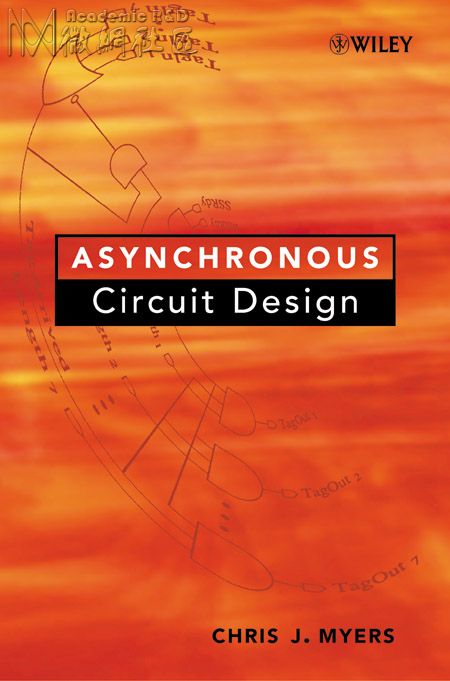
集成电路设计之初,并没有同步和异步的区别,研究的重点在于“mechanical relay circuits”。70年代后,同步设计因为概念简单、设计方便,逐渐成为设计的主流方案。在这一时期,异步集成电路的研究仅仅停留在理论上,研究的出发点也仅仅是它与同步电路不同。90年代初期,同步电路设计仍然占据着数字集成电路设计领域的主导地位,但是由于电路设计规模的扩大和生产工艺的限制,原先可以忽略的互连线之间的延迟、时钟树的负载等已经变得越发突出。设计方法上也面临着很多难以解决的问题(比如,时钟skew问题)。这时,异步电路设计方法重新引起了设计者的重视,与先前为纯粹追求不同的理论而进行的研究已经大不相同,在一定程度上,已经可以作为实际应用中的理论依据和CAD辅助工具。在应用方面,一些面向商业应用的异步集成芯片的出现也有力地证明了异步集成电路在某些方面存在的优势。
目录:
Preface
Acknowledgments
1 Introduction
1.1 Problem Specification
1.2 Communication Channels
1.3 Communication Protocols
1.4 Graphical Representations
1.5 Delay-Insensitive Circuits
1.6 Huffman Circuits
1.7 Muller Circuits
1.8 Timed Circuits
1.9 Verification
1.10 Applications
1.11 Let's Get Started
1.12 Sources
Problems
2 Communication Channels
2.1 Basic Structure
2.2 Structural Modeling in VHDL
2.3 Control Structures
2.3.1 Selection
2.3.2 Repetition
2.4 Deadlock
2.5 Probe
2.6 Parallel Communication
2.7 Example: MiniMIPS
2.7.1 VHDL Specification
2.7.2 Optimized MiniMIPS
2.8 Sources
Problems
3 Communication Protocols
3.1 Basic Structure
3.2 Active and Passive Ports
3.3 Handshaking Expansion
3.4 Reshuffling
3.5 State Variable Insertion
3.6 Data Encoding
3.7 Example: Two Wine Shops
3.8 Syntax-Directed Translation
3.9 Sources
Problems
4 Graphical Representations
4.1 Graph Basics
4.2 Asynchronous Finite State Machines
4.2.1 Finite State Machines and Flow Tables
4.2.2 Burst-Mode State Machines
4.2.3 Extended Burst-Mode State Machines
4.3 Petri Nets
4.3.1 Ordinary Petri Nets
4.3.2 Signal Transition Graphs
4.4 Timed Event/Level Structures
4.5 Sources
Problems
5 Huffman Circuits
5.1 Solving Covering Problems
5.1.1 Matrix Reduction Techniques
5.1.2 Bounding
5.1.3 Termination
5.1.4 Branching
5.2 State Minimization
5.2.1 Finding the Compatible Pairs
5.2.2 Finding the Maximal Compatibles
5.2.3 Finding the Prime Compatibles
5.2.4 Setting Up the Covering Problem
5.2.5 Forming the Reduced Flow Table
5.3 State Assignment
5.3.1 Partition Theory and State Assignment
5.3.2 Matrix Reduction Method
5.3.3 Finding the Maximal Intersectibles
5.3.4 Setting Up the Covering Problem
5.3.5 Fed-Back Outputs as State Variables
5.4 Hazard-Free Two-Level Logic Synthesis
5.4.1 Two-Level Logic Minimization
5.4.2 Prime Implicant Generation
5.4.3 Prime Implicant Selection
5.4.4 Combinational Hazards
5.5 Extensions for MIC Operation
5.5.1 Transition Cubes
5.5.2 Function Hazards
5.5.3 Combinational Hazards
5.5.4 Burst-Mode Transitions
5.5.5 Extended Burst-Mode Transitions
5.5.6 State Minimization
5.5.7 State Assignment
5.5.8 Hazard-Free Two-Level Logic Synthesis
5.6 Multilevel Logic Synthesis
5.7 Technology Mapping
5.8 Generalized C-Element Implementation
5.9 Sequential Hazards
5.10 Sources
Problems
6 Muller Circuits
6.1 Formal Definition of Speed Independence
6.1.1 Subclasses of Speed-Independent Circuits
6.1.2 Some Useful Definitions
6.2 Complete State Coding
6.2.1 Transition Points and Insertion Points
6.2.2 State Graph Coloring
6.2.3 Insertion Point Cost Function
6.2.4 State Signal Insertion
6.2.5 Algorithm for Solving CSC Violations
6.3 Hazard-Free Logic Synthesis
6.3.1 Atomic Gate Implementation
6.3.2 Generalized C-Element Implementation
6.3.3 Standard C-Implementation
6.3.4 The Single-Cube Algorithm
6.4 Hazard-Free Decomposition
6.4.1 Insertion Points Revisited
6.4.2 Algorithm for Hazard-Free Decomposition
6.5 Limitations of Speed-Independent Design
6.6 Sources
Problems
7 Timed Circuits
7.1 Modeling Timing
7.2 Regions
7.3 Discrete time
7.4 Zones
7.5 POSET Timing
7.6 Timed Circuits
7.7 Sources
Problems
8 Verification
8.1 Protocol Verification
8.1.1 Linear-Time Temporal Logic
8.1.2 Time-Quantified Requirements
8.2 Circuit Verification
8.2.1 Trace Structures
8.2.2 Composition
8.2.3 Canonical Trace Structures
8.2.4 Mirrors and Verification
8.2.5 Strong Conformance
8.2.6 Timed Trace Theory
8.3 Sources
Problems
9 Applications
9.1 Brief History of Asynchronous Circuit Design
9.2 An Asynchronous Instruction-Length Decoder
9.3 Performance Analysis
9.4 Testing Asynchronous Circuits
9.5 The Synchronization Problem
9.5.1 Probability of Synchronization Failure
9.5.2 Reducing the Probability of Failure
9.5.3 Eliminating the Probab
